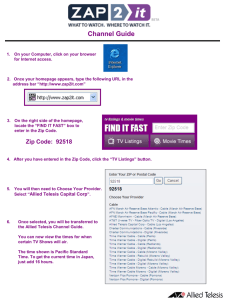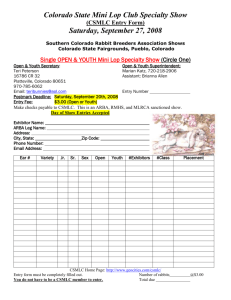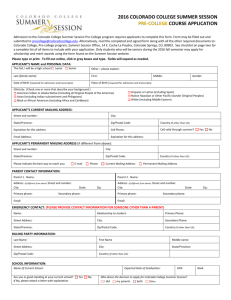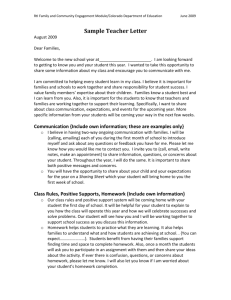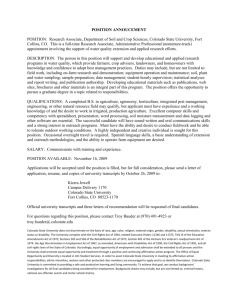Health Insurance by ZIP Code in Colorado
advertisement
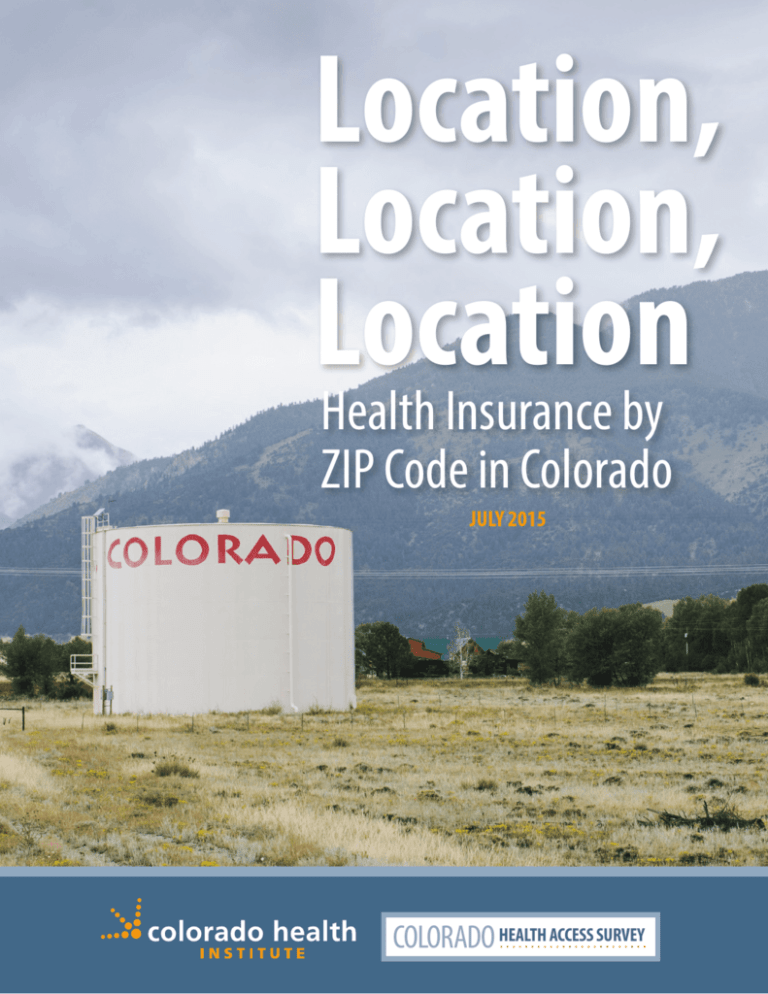
Location, Location, Location Health Insurance by ZIP Code in Colorado JULY 2015 COLORADO HEALTH ACCESS SURVEY Click On Your ZIP Code http://arcg.is/1HgHn2b Go online to find how your ZIP code ranks when it comes to health insurance. The Colorado Health Institute has created an interactive story with maps to accompany this paper. The interactive story map features 458 Colorado ZIP codes, along with information about the three biggest predictors of being uninsured. COLORADO HEALTH ACCESS SURVEY The CHAS is fielded, analyzed and managed by the Colorado Health Institute. It is funded by The Colorado Trust. CHAS Analysis: http://coloradohealthinstitute.org/key-issues/detail/health-coverage-and-the-uninsured/colorado-health-access-survey-1 CHAS Data: http://coloradohealthinstitute.org/data-repository/category/colorado-health-access-survey CHI staff members contributing to this report: Amy Downs, project leader • Rebecca Crepin, statistician • Hannah Wear, interactive maps Brian Clark • Cliff Foster • Deborah Goeken • Joe Hanel • Tamara Keeney Special Thanks: Dr. Ned Calonge, President and CEO, The Colorado Trust Michel Boudreaux, Assistant Professor, University of Maryland School of Public Health, Department of Health Services Administration Location, Location, Location Health Insurance by ZIP Code in Colorado Table of Contents 4Introduction 7 ZIP Codes and Health Insurance: Colorado’s Top 10 and Bottom 10 9 ZIP Codes and Health Insurance: Painting a More Detailed Picture 10 The Front Range: Fort Collins to Colorado Springs 12 Northeastern Colorado and the Eastern Plains 14 Southeast Colorado 16 Southwestern Colorado and the San Luis Valley 18 Mountain Resorts and Northwestern Colorado 20 How We Did It 20 Next Steps 21Conclusion 22 End Notes Location, Location, Location: Health Insurance by ZIP Code in Colorado Sometimes a few blocks can make a world of difference. A person living in Englewood’s 80110 ZIP code, for instance, has one of the worst chances of having health insurance in Colorado. But a neighbor just to the south across Belleview Avenue has one of the best chances. Across the country, there is growing awareness that place matters when it comes to health. Local environments contribute to the overall health, for good or ill, of their residents. Some communities lack sidewalks and parks, wellpaying jobs, or convenient access to healthy 4 Colorado Health Institute foods. Others are rich in such advantages and many more. It is clear that place matters when it comes to health insurance, too. A new statistical model developed by the Colorado Health Institute (CHI) finds that probabilities of being uninsured JULY 2015 in Colorado range from a low of 5.71 percent in two ZIP codes in Broomfield and Douglas counties to a high of 36.03 percent in one Crowley County ZIP code. CHI’s model takes the most reliable data on health insurance, the Colorado Health Access Survey (CHAS),1 and pairs it with demographic information by ZIP code, making it possible to examine localized disparities in great detail. This hyperlocal understanding of who has health insurance – and who doesn’t – opens new possibilities for targeting intervention efforts and resources where they can make the most difference. The model identifies six socioeconomic factors that are the best community-level predictors of whether residents in a given ZIP code are likely to be uninsured. This study focuses only on those under the age of 65 because nearly all seniors have Medicare coverage, regardless of where they live. The six most predictive factors, in order of importance, for Coloradans under the age of 65 are: 1. POVERTY Income is strongly correlated with health insurance. Nearly one of four Coloradans (24.1 percent) below the poverty line is uninsured, according to the 2013 CHAS.2 For 2015, the poverty line is an annual income of $11,770 for a single person and $24,250 for a family of four. The CHI model finds that poverty is the single most important predictor of being uninsured. ZIP code analysis: language is English. Both the CHAS and the U.S. Census gauge the level of comfort with English by asking about the language spoken at home. The CHI model finds a higher probability of being uninsured when that language is Spanish. Colorado has about 550,000 residents who speak Spanish at home, or about 12.2 percent of the population. Most of the state’s Spanish speakers – about nine of 10 – are Hispanic, a group that is disproportionately uninsured in Colorado. The CHI model indicates that the sub-population of Hispanics who primarily speak Spanish face even higher barriers to obtaining health insurance coverage. ZIP code analysis: The ZIP code with the highest percentage of the population that speaks Spanish at home — 61.4 percent — is Lake County’s 81251. Two ZIP codes in Dolores County and one small ZIP code in Gunnison County report no Spanish speakers. 3. AGE Neighborhoods with median ages falling within two fairly broad age groups – pre-retirees between 46.1 and 58.4 and an expanded “young invincibles” cohort between 19.6 and 36.7 – are the most likely to be uninsured. The older group may reflect fallout from the recession, with some laid-off workers still unable to find jobs. Also, when these data were collected in 2013, many low-income adults did not qualify for Medicaid. Meanwhile, the “young invincible” group has traditionally had the state’s highest level of uninsurance. ZIP code 81633 near Dinosaur in Moffat County has the highest percentage of residents below the poverty line at 33.3 percent. Nine ZIP codes report no residents below the poverty line. ZIP code analysis: 2. SPANISH SPOKEN AT HOME 4. UNEMPLOYMENT Non-English speakers tend to have a tougher time becoming insured than those whose first The ZIP code with the youngest median age of 19.6 is 80309 in Boulder County near the CU campus. The ZIP code with the oldest median age is 80545 in Red Feather Lakes in Larimer County. Most Coloradans get health insurance through their employer. That leaves the unemployed Colorado Health Institute 5 Location, Location, Location: Health Insurance by ZIP Code in Colorado with the option to buy their own insurance or remain uninsured, which is often the case. Nearly 44 percent of unemployed Coloradans looking for work – this excludes the unemployed who weren’t in the labor force – did not have health insurance in 2013. ZIP code analysis: Eagle County ZIP code 80463 has the highest percentage of unemployed at 16.1 percent. Three small ZIP codes in Moffat, Baca and Kiowa counties report no unemployed residents. 5. RENTING Coloradans who rent their living quarters have a higher chance of being uninsured. This most likely reflects lower income levels as well as age, with many renters fall into the “young invincible” category. But even adjusting for age and income, the proportion of renters in a community is still an important predictor of being uninsured. At least one of four renters nationally now pay more than half their income on housing and utilities, leaving little left over for health insurance.3 ZIP code analysis: Fort Carson, Peterson Air Force Base and the Air Force Academy ZIP codes in Colorado Springs lead the state for renters. Arvada’s 80007 ZIP code has the lowest percentage of renters. 6. HOUSEHOLD SIZE Members of the smallest households, those with one or two people, have the highest chances of being without health insurance. Again, the “young invincible” age group is present in this category, with many still single and living alone. Because Colorado has made great strides toward getting most children covered, members of larger households with children are less likely to be uninsured. 6 Colorado Health Institute ZIP code analysis: The ZIP code with the lowest average household size is 80203 in downtown Denver at 1.37. El Paso County’s 80913 ZIP code has the largest average household size of 3.96. CHI’s statistical model predicts the probability of not having health insurance in each ZIP code based on the unique characteristics of that ZIP code. We found that ZIP codes with more poverty or Spanish speakers or renters, for example, have better chances of being home to more uninsured residents. It is likely additional factors that would also predict uninsurance aren’t included in the model. CHI selected only factors with data available at the ZIP code level. If more factors were available, the model would be more robust. This model produces the probability of not having insurance, not actual counts of uninsurance. What this means is that if a ZIP code has a 25 percent probability of being uninsured, for example, any resident under the age of 65 who is selected at random will have a one-in-four chance of being without health insurance. For analysis purposes, CHI divided Colorado’s ZIP codes into quartiles: • 5.7 percent to 11.8 percent (lowest probability of being uninsured); • 11.9 percent to 16.5 percent; • 16.6 percent to 20.9 percent; and • 21.0 percent to 36.0 percent (highest probability of being uninsured). CHI has performed statistical tests of the model and believes that it provides the most accurate probabilities of residents being uninsured at the community level to date. And, perhaps just as significantly, it provides information on the factors that make it more likely Coloradans will not have health insurance. JULY 2015 ZIP Codes and Health Insurance Colorado’s Top 10 and Bottom 10 Do you live in ZIP code 80023 in Broomfield? Chances are very, very good that you have health insurance. The same goes for ZIP code 80126 in Highlands Ranch. These two neighborhoods are tops for health insurance coverage. Their residents have just a 5.7 percent probability of being uninsured, the lowest in the state. Suburban ZIPs in Douglas and Boulder counties, along with areas of Weld and Elbert counties, round out the top 10. The news is much different if you live in ZIP code 81076 in rural Crowley County east of Pueblo. This is Colorado’s worst ZIP code for health insurance. Residents of 81076 have the highest probability of being uninsured in the state at 36.0 percent. Closely following are their neighbors just to the south in the Rocky Ford ZIP code of 81067 in Otero County. The remaining ZIP codes in the bottom 10 are scattered throughout rural areas of southern and western Colorado, including the San Luis Valley. In general, CHI’s ZIP code analysis produces a “U” shape on a map of the state, with ZIP codes in the fourth quartile — those most likely to be uninsured — clustered in southern Colorado, many on the border with New Mexico, climbing up Colorado’s Western Slope to Garfield and Mesa counties and up the state’s eastern border to Sedgwick in the far northeast corner. (See Map 1.) Map 1. Probability of Being Uninsured by ZIP Code, Colorado* * No data are available for 80225 (Denver), 80476 (Silver Plume), 80474 (Rollinsville), 80444 (Georgetown), 80438 (Empire), 80436 (Dumont) 80427 (Central City), 00027 (Pike National Forest) Colorado Health Institute 7 Location, Location, Location: Health Insurance by ZIP Code in Colorado Colorado’s Top 10 and Bottom 10 ZIP Codes TOP 10 Lowest probability of being uninsured for population under 65. Rank ZIP Probability Town County 1 1 3 4 5 6 7 8 9 9 80023 80126 80125 80516 80534 80027 81648 80138 80130 80134 5.71% 5.71% 5.77% 5.79% 5.84% 5.85% 5.91% 5.96% 6.02% 6.02% Broomfield Highlands Ranch Roxborough Park Erie Johnstown Louisville/Superior Rangely Parker Highlands Ranch Parker/The Pinery Broomfield Douglas Douglas Weld/Boulder Weld Boulder Rio Blanco Douglas/Elbert Douglas Douglas BOTTOM 10 Highest probability of being uninsured for population under 65. Rank ZIP Probability Town County 1 2 3 4 5 5 7 8 9 10 10 10 10 81076 80167 81419 81147 81143 81155 81123 81630 81120 81027 81049 81081 81084 36.03% 34.03% 32.80% 32.41% 31.53% 31.53% 31.18% 31.09% 30.96% 30.68% 30.68% 30.68% 30.68% Sugar City Rocky Ford Hotchkiss Pagosa Springs Moffatt Bonanza Blanca DeBeque Antonito Branson Branson Trinchera Two Buttes Crowley Otero Delta Archuleta/Hinsdale/Mineral Saguache Saguache Costilla Garfield/Mesa Conejos Las Animas Las Animas Las Animas Baca 8 Colorado Health Institute JULY 2015 ZIP Codes and Health Insurance Painting a More Detailed Picture The picture of health insurance coverage in Colorado has been painted with broad brush strokes until now, based on 21 Health Statistics Regions. The Colorado Department of Public Health and Environment divided the state into these geographic regions in order to standardize health-related analysis. Sparsely populated counties were rolled up into single regions while bigger counties were designated as their own regions. The statewide uninsured rate for all residents under 65 was 16.0 percent in 2013 when the last CHAS was fielded. The CHAS found that regional uninsured rates ranged from a low of 6.0 percent in Region 3 (Douglas County) to a high of 29.0 percent in Region 11 (Moffat, Routt, Jackson and Rio Blanco counties in northwest Colorado). CHI’s new ZIP code model zeroes in on communities and even neighborhoods, revealing a more nuanced picture of health insurance. We have divided the state into five areas for this analysis: the Front Range, northeastern Colorado, southeastern Colorado, southwestern Colorado and northwestern Colorado. (See Map 2.) Map 2. Five Analysis Areas Based On Health Statistics Regions, Colorado Colorado Health Institute 9 Location, Location, Location: Health Insurance by ZIP Code in Colorado The Front Range: Fort Collins to Colorado Springs BRIAN CLARK/CHI Regional Health Insurance Rates This area from Fort Collins in the north to Colorado Springs in the south is home to the largest proportion of the state’s population — and the largest proportion of uninsured as well. The diversity of Front Range residents is reflected in the diversity of its uninsured rates, ranging from the state’s lowest rate to areas higher than the state average. Douglas County continues to be the gold standard for health insurance, with an uninsured rate of 6.0 percent. Uninsured rates soar more than three times higher just miles away, reaching 19.0 percent in nearby Denver and Arapahoe counties and 17.0 percent in Adams County. El Paso County, home to Colorado Springs, has a 14.5 percent rate. Delving Deeper: Health Insurance by ZIP Code Deep disparities in health insurance mark neighborhoods across the Front Range. In some cases, we found wide variations across a single street. In a tale of two Denver neighborhoods, the relatively affluent and newer neighborhoods 10 Colorado Health Institute HSR County 2 3 4 14 15 16 20 21 Larimer Douglas El Paso Adams Arapahoe Boulder, Broomfield Denver Jefferson State Percentage Uninsured Percentage Uninsured 17.2% 6.0% 14.5% 17.0% 19.0% 12.2% 19.0% 13.3% 16.0% Source: Colorado Health Access Survey of Stapleton and Northfield (ZIP code 80238) have the city’s lowest probability of uninsurance at 9.3 percent. Just to the east, across Havana Street in the Montbello neighborhood (ZIP code 80239), the probability that residents don’t have health insurance jumps to 23 percent, the city’s highest. (See area detail in Map 3.) The primary difference? Poverty and unemployment. Montbello’s poverty rate is four times higher than that of Stapleton/Northfield JULY 2015 Map 3. Probability of Being Uninsured by ZIP Code, Denver Find the complete Front Range interactive ZIP Code map at http://arcg.is/1HgHn2b while its unemployment rate is three times higher. Montbello has a much higher rate of Spanish-speaking residents as well. Jefferson County, west of metro Denver, exhibits a wide range of health insurance probabilities. ZIP codes clustered around the C-470 and 6th Avenue corridors are most likely to have high rates of uninsurance. Sixth Avenue, in particular, is a line of division. A resident of ZIP code 80215 on the north side of 6th Avenue has a one of four chance of being uninsured. That probability decreases to one of 10 for a resident of ZIP code 80228 on the south side of 6th Avenue. The biggest difference in contributing factors between these neighborhoods is the percentage of Spanish speakers and residents living in poverty. The metropolitan centers of Denver and Colorado Springs have higher probabilities of uninsurance than their surrounding suburban areas. The city centers have a good number of Spanish speakers, residents living in poverty and renters. This holds true for urban areas in Adams and Arapahoe counties as well. While the uninsured rate of Boulder and Broomfield counties (Region 16) is below the state average, there is wide variation at the community level. Downtown Longmont (ZIP code 80501) has Region 16’s highest likelihood of being uninsured at 22.0 percent, with many Spanishspeakers, renters, and those living in poverty or out of work. Just 20 miles away in Broomfield, however, is the state’s top ZIP code for health insurance (80023) with only a 5.7 percent probability of uninsurance. In Larimer County, there is a wide difference between the two largest cities, Fort Collins and Loveland. A resident of the 80526 ZIP code of Fort Collins, home to Colorado State University, has a one in eight probability of being uninsured. In Loveland’s 80537 ZIP code, the chance of being uninsured increases to nearly one in five. Colorado Health Institute 11 Location, Location, Location: Health Insurance by ZIP Code in Colorado Northeastern Colorado and the Eastern Plains Burlington in Kit Carson County. BRIAN CLARK/CHI Regional Health Insurance Rates Sometimes referred to as Colorado’s frontier, the region encompassing the northeast corner of the state and the Eastern Plains is home to many of the state’s farms and ranches.4 The northeast counties of Sedgwick, Phillips and Washington, in particular, are sparsely populated. Uninsurance rates run from 10.2 percent in Weld County to nearly 18 percent in the northeast Region 1 counties. The Region 5 Eastern Plains counties of Elbert, Lincoln, Kit Carson and Cheyenne have an uninsured rate of 11.1 percent. Delving Deeper: Health Insurance by ZIP Code Residents in ZIP codes closer to the Front Range and metro Denver have better chances of being 12 Colorado Health Institute HSR 1 5 18 County Morgan, Washington, Logan, Sedgwick, Phillips, Yuma Elbert, Lincoln, Kit Carson, Cheyenne Weld State Percentage Uninsured Percentage Uninsured 17.8% 11.1% 10.2% 16.0% Source: Colorado Health Access Survey insured compared with those in outlying areas. Further east, especially in the more remote parts of both Regions 1 and 5, there are large differences in the risk of being uninsured. JULY 2015 Map 4. Probability of Being Uninsured by ZIP Code, Northeastern Colorado and the Eastern Plains Find the complete Northeastern Colorado and Eastern Plains interactive ZIP Code map at http://arcg.is/1HgHn2b For example, the chances of being uninsured differ by 19 percentage points between Wray, where the probability is seven percent, and its outskirts, where the likelihood climbs to 26 percent. Residents of Fort Morgan and Sterling, the other cities in Region 1, have about a 20 percent chance of lacking insurance, likely due to high percentages of Spanish speakers and people in poverty. borders Douglas County. It has the lowest likelihood that residents have no coverage. But localities closer to Colorado’s eastern border have higher probabilities of uninsurance. ZIP codes 80861 in Kit Carson County and 80825 in Cheyenne County show the highest likelihoods of being uninsured. Many residents in these ZIP codes are older, low income or primarily speak Spanish. Meanwhile, depending on where a person lives in the Eastern Plains counties of Region 5, chances of being uninsured range from eight percent to 27 percent. Meanwhile, most of Weld County’s communities have low- or medium-low chances of being uninsured. The probability is as low as six percent for a few cities just west of Greeley that lie along the Interstate 25 corridor, such as Johnstown and Windsor. Region 5’s most populated ZIP code, 80107, Colorado Health Institute 13 Location, Location, Location: Health Insurance by ZIP Code in Colorado Southeastern Colorado Las Animas in northeast Colorado. BRIAN CLARK/CHI Regional Health Insurance Rates One of five residents of southeastern Colorado’s Region 6, a sparsely populated corner of the state, is likely to lack health insurance. This places Region 6 in sixth place in Colorado for uninsurance. The area has been losing both jobs and population in recent years. Government is the largest employer, dominated by jobs at area prisons, followed by agriculture.5 The population of southeastern Colorado has declined over the past several decades and has a relatively high concentration of seniors. 14 Colorado Health Institute HSR 6 7 Counties Crowley, Kiowa, Bent, Prowers, Baca, Otero, Huerfano, Las Animas Pueblo State Percentage Uninsured Percentage Uninsured 20.0% 13.8% 16.0% Source: Colorado Health Access Survey Pueblo County, which is Region 7, has a lower likelihood of being uninsured at 13.8 percent compared with communities to the east. JULY 2015 Map 5. Probability of Being Uninsured by ZIP Code, Southeastern Colorado Find the complete Southeast Colorado interactive ZIP Code map at http://arcg.is/1HgHn2b An economic center in the late 19th century, with plentiful employment opportunities, Pueblo became home to workers from all over the world. This contributed to an ethnic diversity that still exists. But Pueblo has struggled to replace the jobs it lost when the steel market crash of the early 1980s shuttered a major employer in the city. Delving Deeper: Health Insurance by ZIP Code Two ZIP codes in southeastern Colorado stand out. Residents of 81076 in Crowley County have the highest likelihood of being uninsured at 36 percent followed by ZIP code 81067 in the Rocky Ford area of Otero County at 34 percent. Rocky Ford, renowned for its cantaloupe, relies on seasonal farmworkers for production, a group that is unlikely to have health insurance.6 These probability rates are the highest statewide. Lamar, the county seat of Prowers County, is the largest population center, and its residents have the least risk of uninsurance in the region. This is due to its lower unemployment rate relative to the rest of the region. In Pueblo, ZIP codes with the lowest probability of uninsurance include the northern part of the county (10 percent) and Pueblo West (17 percent). While unemployment in the city of Pueblo is relatively high, a smaller proportion of its residents are below the poverty line compared with the rest of the region. Residents in the northwest part of Pueblo County in ZIP code 81025 have the highest risk of being uninsured at 31 percent. This community is characterized by high unemployment, poverty and Spanish speaking residents. Colorado Health Institute 15 Location, Location, Location: Health Insurance by ZIP Code in Colorado Southwestern Colorado and the San Luis Valley Near Alamosa in southwestern Colorado. BRIAN CLARK/CHI Regional Health Insurance Rates Part of this area is rural and mountainous, but it also covers the San Luis Valley. The major population center is Grand Junction. Compared with the rest of the state, three of the six regions have above-average uninsurance rates — Mesa County, which is Region 19; Region 10, which covers the rural areas of Gunnison, Delta, Montrose, San Miguel, Ouray, Hinsdale and Mineral counties; and the San Luis Valley in Region 8. In fact, Region 10 has the state’s second highest overall uninsurance rate. The Four Corners region has an uninsured rate of 19.4 percent, slightly above the state average of 16.0 percent. Tourism is an important economic driver in this area. The proportion of retirees is slightly higher than the state average. It is also host to a changing population. Region 10’s Hispanic population, for example, increased 54 percent from 2000 to 2010 while the white population increased 11 percent.7 16 Colorado Health Institute HSR 8 9 10 13 17 19 County Saguache, Mineral, Rio Grande, Alamosa, Conejos, Costilla Dolores, San Juan, Montezuma, La Plata, Archuleta Delta, Gunnison, Montrose, San Miguel, Ouray, Hinsdale Lake, Chaffee, Fremont, Custer Gilpin, Clear Creek, Park, Teller Mesa State Percentage Uninsured Percentage Uninsured 20.7% 19.4% 26.6% 16.1% 16.2% 22.1% 16.0% Source: Colorado Health Access Survey JULY 2015 Map 6. Probability of Being Uninsured by ZIP Code, Southwestern Colorado and the San Luis Valley Find the complete Soutwest Colorado interactive ZIP Code map at http://arcg.is/1HgHn2b Delving Deeper: Health Insurance by ZIP Code Some of the state’s best ZIP codes are next to some of the worst in terms of insurance coverage. Residents of the southwestern ski resort towns are the most likely in this area to have health insurance, despite higher premium costs. Residents of economically struggling areas, including the San Luis Valley, are among the least likely to be insured. Grand Junction is the area’s only urban area, and we found stark disparities between the city and its outlying communities. People in city ZIP codes have between an 11 percent and 19 percent chance of lacking insurance. But people in nearby communities have lower probabilities of being uninsured. The rate is 9.5 percent in Fruita and eight percent in Loma. Residents in two main Four Corners communities, Cortez and Pagosa Springs, are much more likely to be uninsured. In fact, due to their older populations and high unemployment rates, they have among the highest chances of being uninsured in the state. The rate is 27 percent in Pagosa Springs and 32 percent in Cortez. But if you were driving between the two towns, you would go through Durango, where residents have a likelihood of being uninsured about half that of their neighbors in Pagosa Springs and Cortez. The probability of being uninsured in Durango’s ZIP code 81301 is 14 percent because of lower poverty. The lack of insurance in the Four Corners region is concentrated in and around Montrose. Similar to the ski resort towns to the north, residents of Crested Butte and Telluride enjoyed the lowest probabilities of being uninsured in this corner of the state. The worst ZIP codes for health insurance in this area are all in places where the economy has struggled and poverty is high, including the San Luis Valley. ZIP codes 81143 and 81149 in Saguache County have uninsured probabilities of 32 percent, the region’s highest. Colorado Health Institute 17 Location, Location, Location: Health Insurance by ZIP Code in Colorado Mountain Resorts and Northwestern Colorado Aspen in Pitkin County. BRIAN CLARK/CHI Regional Health Insurance Rates Some of Colorado’s most beautiful vistas are found in this area, which encompasses the state’s mountain ski resorts as well as Dinosaur National Monument in the far northwest corner. But many residents are without health insurance. In fact, statewide, the region encompassing Moffat, Rio Blanco, Routt, and Jackson counties has the highest uninsured rate of 29 percent, nearly twice the state average of 16 percent. The mountain resort region of Garfield, Eagle, Pitkin, Grand and Summit counties ranks fourth at 21.7 percent. Delving Deeper: Health Insurance by ZIP Code The high rates of uninsurance conceal the fact that residents of the ski resort towns — Aspen, 18 Colorado Health Institute HSR 11 12 County Moffat, Rio Blanco, Routt, Jackson Garfield, Eagle, Grand, Summit, Pitkin State Percentage Uninsured Percentage Uninsured 29.0% 21.7% 16.0% Source: Colorado Health Access Survey Vail, Steamboat Springs, Breckenridge and Winter Park — are among the Coloradans most likely to have health insurance. The probability of being uninsured hovers between eight percent and 12 percent in these towns, below the state average. This finding is JULY 2015 Map 7. Probability of Being Uninsured by ZIP Code, Mountain Resorts and Northwestern Colorado Find the complete Mountain Resorts and Northwestern Colorado interactive ZIP Code map at http://arcg.is/1HgHn2b interesting after it was revealed last year that insurance premiums in these areas are among the highest in Colorado. And while the ski towns do well when it comes to health insurance, residents in the surrounding areas — perhaps where many resort workers live — are not as likely to be insured. For example, Breckenridge residents have a 10 percent chance of being without health insurance. But the chances go up for those living in the surrounding towns, with Dillon at 16 percent, Frisco at 16 percent and Silverthorne at 17 percent. The probability of being uninsured in Aspen is 11 percent, but nearby Snowmass is at 22 percent. The probability of being uninsured in Steamboat Springs is 12 percent, but it jumps to 19 percent in nearby Oak Creek and 21 percent in Clark. Meanwhile, it is the people living in the more isolated towns and rural areas who are much more likely to be uninsured. Residents of the larger non-resort towns, such as Glenwood Springs and Granby, also have higher chances of being uninsured. Rio Blanco County is an interesting study in contrasts. The ZIP codes surrounding the towns of Rangely and Meeker have the region’s and the state’s lowest probabilities of being uninsured, six percent and nine percent respectively. An economy bolstered by the oil and gas boom may account for this. But Rifle, located between the two towns, has a much higher probability, 16 percent. In Moffat County, residents of the town of Dinosaur and the surrounding areas have more than a one in five probability (22 percent) of not having health insurance. But a sparsely populated and remote area near the border with Wyoming, ZIP code 81653, bucks the trend with the county’s lowest probability of 11 percent. Colorado Health Institute 19 Location, Location, Location: Health Insurance by ZIP Code in Colorado How We Did It Being uninsured is often correlated with a variety of demographic factors. In order to create the ZIP code model, CHI obtained a dataset from Neilson Marketing Services, which estimates many of those demographic factors based on market surveys. We chose factors for their ability to help predict uninsurance. selection to determine the final set of significant predictors for being uninsured. During this process, educational attainment, median household income, mean travel time to work and median house value fell out of the model. These six factors, listed in order of predictive value, were found to be the most important predictors of being uninsured: The demographic factors from Neilsen were appended to CHAS data by matching the ZIP codes. All seniors aged 65 and older were removed from the data file since nearly all of them have insurance through Medicare. This resulted in a dataset with a record for each individual containing their insurance status, demographic information and ZIP code. 1. Poverty From this combined dataset, CHI created a logistic regression model with backwards 6. Household Size 2. Spanish Spoken at Home 3. Age 4. Unemployment 5. Renting By plugging in the demographic factors found in each ZIP code, the model calculated the probability of an individual being uninsured for each ZIP code in Colorado. Probabilities and Estimates The new CHAS ZIP code data gives a probability that someone in a given ZIP code will be uninsured, not an estimate of the uninsured population in that ZIP code. It is a subtle yet important difference. The CHAS uses a telephone survey sample to derive estimated numbers of uninsured people. The new ZIP code analysis combines those estimates with other data to generate a probability that any given person in a certain ZIP code will lack insurance based on the characteristics of their community. The probability number should not be reported as the percentage of people in each ZIP code who are uninsured. 20 Colorado Health Institute Next Steps CHI anticipates that these 2013 data will have changed in important ways following the 2014 implementation of major insurance reforms in the Affordable Care Act. CHI plans to employ data from the 2015 CHAS, which will be available later this year, to conduct an updated ZIP code analysis that will cover health insurance as well as local differences in health, use of care and barriers to receiving care. The goal is to make the CHAS even more relevant to people in neighborhoods across Colorado and to point the way to better health for all. JULY 2015 Conclusion Community characteristics are important in understanding the health insurance landscape. And CHI’s analysis clearly demonstrates that health insurance disparities exist even within small geographic areas throughout the state. Delving deeper into the predictors of uninsurance illuminates how interventions might target efforts to address uninsurance. While one community’s probability of uninsurance may be due to a high prevalence of pre-retirees, another community’s probability may be due to a high prevalence of those who speak Spanish. Regardless of the reasons, these insights can help state and local leaders hone in on the starkest disparities and better understand how to target Colorado neighborhoods and communities to increase insurance coverage. Where you live matters because health – and health insurance – is local. Fort Garland in the San Luis Valley. BRIAN CLARK/CHI Colorado Health Institute 21 Location, Location, Location: Health Insurance by ZIP Code in Colorado End Notes 1 http://coloradohealthinstitute.org/key-issues/detail/health-coverage-and-the-uninsured/colorado-health-access-survey-1 2 http://coloradohealthinstitute.org/data-repository/category/colorado-health-access-survey 3 http://www.inc.com/associated-press/more-americans-spending-at-least-half-their-pay-on-housing.html 4 https://dola.colorado.gov/demog-cms/sites/dola.colorado.gov.demog-cms/files/demog-docs/presentations_publications/region1.pdf 5 https://dola.colorado.gov/demog-cms/sites/dola.colorado.gov.demog-cms/files/demog-docs/presentations_publications/region6.pdf 6 https://kaiserfamilyfoundation.files.wordpress.com/2013/01/migrant-and-seasonal-farmworkers-health-insurance-coverage-and-accessto-care-executive-summary.pdf 7 https://dola.colorado.gov/demog-cms/sites/dola.colorado.gov.demog-cms/files/demog-docs/presentations_publications/region10.pdf 22 Colorado Health Institute JULY 2015 Colorado Health Institute 23 H E A LT H I N ST I TE CO LO DO TU RA M H EA OR LT H INF N I G PO LICY • A D VA NC IN G The Colorado Health Institute is a trusted source of independent and objective health information, data and analysis for the state’s health care leaders. The Colorado Health Institute is funded by the Caring for Colorado Foundation, Rose Community Foundation, The Colorado Trust and the Colorado Health Foundation. 303 E. 17th Ave., Suite 930, Denver, CO 80203 • 303.831.4200 coloradohealthinstitute.org
